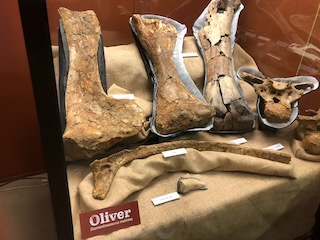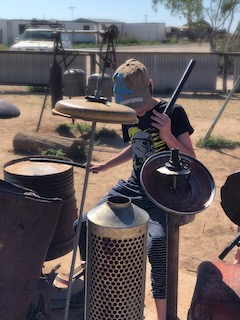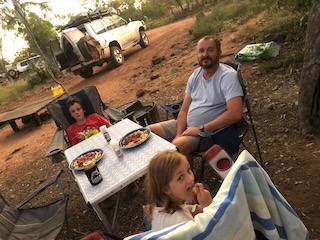After 4 wonderful nights and 3 glorious days at Porcupine Gorge with echidnas and bettongs and snakes (oh my!) it was time to move on. To Winton and more Dinosaur adventures We had chatted to some fellow travellers who had come from Winton and had some comments or advice.
First comment was that the flies are pretty bad. How bad could they be? Advice was not to miss the Gregory North Banjo Paterson show at the North Gregory Hotel. It all made perfect sense.... And also that you should book the final two dinosaur attractions on our muliti-pass; Australian Age of the Dinosaurs and Lark Quarry Dinosaur Stampede National Monument.
 Down town Winton - green grass gets the thumbs up from the kids. And yep the flies were bad.
Down town Winton - green grass gets the thumbs up from the kids. And yep the flies were bad.
.jpeg)

More silly photo opportunities that could not be resisted.
We pulled in to Winton about 1pm on a Monday- good timing we thought. We had fancied a bakery lunch but found that a large group travelling on motorbikes had bought the entire town out of any fast and easy take away meals.
We ended up at the North Gregory Hotel for lunch having a yummy bistro meal. The North Gregory Hotel is one of 4 hotels in Winton, a town of less than 1000 people in the 2016 census. The current, and 4th, version of the North Gregory was finished in 1955 after the previous 3 versions (1899, 1916 & 1946) burnt down. Fires are a common theme in Winton. One of the other pubs in town had sections closed due to fire.
While in town we also took advantage of free showers ( had been in the bush for 4 nights if you recall, and swimming is not quite the same) at one of the roadhouses. We also obtained some town water, bore, which the lady at the Visitors centre assured me would be fine if we just let the sulphur blow off ( it was ).
While at the pub I took the opportunity to call the Australian Age of the Dinosaurs to book us in for our visit. We really wanted to be there for James' 12th birthday the very next day and the lady was very patient and had to move a whole lot of stuff around to accommodate our family. But she did it, and we were very grateful! We were now all booked in for Age of the Dinosaurs and the Dinosaur Stampede the following day.
 |
I know this looks like big flat empty nothing country. This is the drive into Bladensburg National Park, about a 20km drive from Winton where we camped on the river bank for 4 nights and used as a (not always convenient) base to explore Winton and surrounds.
I love this type of country. The sky is just huge. I love the colours. The tough animals and plants that thrive here. Getting up early and sitting quietly is so rewarding. The smells and sounds. I love the openness. I love that for an hour after sunset the horizon blazes tangerine and mauve and blue. And then the stars - wall to wall. The camp ground was teeming with budgies, and I mean teeming. Like most Australian parrots their crazy bright plumage is surprisingly cryptic in the apparently drab colours of the outback - you really would not think a bright yellow and jewel green bird would be so difficult to see in the yellow spinifex and grey green of the gum trees. Walking up to a clump of spinifex could yield dozens of the bright green little birds, chattering and squeaking as they fly away. Big flocks of them would explode up from the side of the road as we drove along and it became a bit of a game to try and predict where the next 'big' flock would be. Late rain makes for lots and lots of happy budgies around Winton. They were everywhere - in every tree, on stumps and in the grass. |
 |
| Camp set up #1 Bladensburg - we ended up moving to a better neighbourhood the next morning |

HAPPY 12TH BIRTHDAY TO JAMES! Chocolate cake for breakfast!


The kids posing with 'Banjo' at the entrance to The Australian Age of Dinosaurs ( I will abbreviate to Age of Dinos). Banjo is an
Australovenator wintonensnis a theropod dinosaur found with sauropod 'Matilda'
Diamantinasaurus matildae on nearby Elderslie Station in 2005 by the station owner. They are dinosaurs from the Middle Cretaceous period approximately 100-95MYO.
On entering reception and checking in we were given a timetable as you cannot freely walk around the entire site. The kids were each given a special guide to complete as we went along. There are 4 different areas to experience at Age of Dinos; the fossil preparation laboratory, reception and collection room, March of the Titanosaurs exhibition and Dinosaur canyon and outdoor galleries.
First stop was the March of the Titanosaurs exhibition. This was a guided tour through a large made-for-purpose building to protect the 54m long dinosaur footprints, or trackway. The footprints are a relatively recent discovery on (yet another) nearby cattle station, "Karoola".
The trackway is known as the Snake Creek tracksite and required the excavation, removal and reassembly of tonnes and tonnes of rock, like an enormous and very significant jigsaw puzzle. Our guide brought the trackway to life for us and explained that we were looking at a snapshot of an (extra)ordinary day near the river or billabong 95million years ago; it was a landscape covered in temperate rainforest - very different to the Jump-up (mesa plateau) the AODD is on today.
Footprints include 4 individual sauropods, including a juvenile, as well as tracks from crocodyloformsi, lungfish, turtles, and ornithopod and therapod dinosaurs all going about their daily business. There is no real drama in the trackway (very different to the Lark Quarry trackway to come) but offers palaeontologists insight into how these animals lived and behaved.
Bronze statues of the titanosurs
Next we headed to the Dinosaur Canyon outdoor galleries. The kids busied themselves with plaque rubbings at each exhibit to complete their guide books. The adults shooed flies and assisted where necessary. The flies made being outside pretty unpleasant and I am ashamed to say that we rushed this part a little in order to escape the meaning flies. There were 5 exhibits in all; Death in the billabong ( photo below), Cretaceous Garden (in progress), Pterodactylus family, Dinosaur Stampede and the Kunburrasuarus exhibit, all accessed form a raised walkway.
Plaque rubbings
Above 2 photos are part of the dinosaur stampede exhibit showing a single large, predatory therapod dinosaur causing smaller theropod and ornithopod dinosaurs to bolt in an attempt to escape. More on this soon.
We hopped back on the courtesy bus to take us back to reception to eat our packed sandwiches ( and some flies) before heading for the next scheduled guided tour; the preparation lab. This was probably the part of the day I was most looking forward to, with the added bonus that it was inside and away from the bloody flies.
Big legs of sauropod found near Winton. The Winton area has produced more large dinosaur fossils than any other part of Australia, and new sites are being discovered every year. There is currently a back-log of about 10 years work in the AODD prep lab!
The preparation lab was another guided tour with lots of information about just a fraction of some of the incredible finds in the region. We were able to touch some of the 95MYO leg bones of sauropod dinosaurs.
Neck vertebra of a big sauropod dinosaur in the prep lab in the process of being cleaned and assembled. There were several volunteers working on some fossils in the lab who happily fielded questions about all things dinosaur and fossil. I learnt all about the jacketing process, and how it is done in the field to ensure the fossils are safe from breakage but also from changing atmospheric conditions so that they can be transported and potentially stored until someone is ready to prepare and study them.
The fossil preparation lab at AODD had floor to ceiling shelves full of jacketed specimens from many dig locations just waiting to be cracked open. Years of work ahead.
Last stop at the AODD was the Collection room, which again had a short presentation by a guide as well as a brief movie and animations to explain various aspects of the dinosaurs being studied here. the collection room contained the holotype (first known) specimens of 'Banjo', 'Matilda' and 'Elliott' Saranasaurus elliottorium (another sauropod) and Ferredraco lentoni - the most complete pterosaur fossil found in Australia.
The Australian Age of Dinosaurs Museum exceeded our expectations. It is a stunning facility in its location and presentation. I thoroughly enjoyed the fact that it isn't just a museum in the static sense, but a work-in-progress. We got to learn about why it has been built, what is happening and what is next. I got the sense that we are in a very exciting phase of dinosaur discovery in Australia. James had a fantastic and unforgettable 12th birthday - who doesn't love dinosaurs?
 |
| Jem posing with her Australian Dinosaur merchandise - super cool T-shirt, limited edition Aussie dinosaur Top Trumps game and new softy "Matilda" |
After our day at the Age of Dinosaurs museum we headed to the North Gregory Hotel to catch Gregory North's fantastic live show reciting Banjo Paterson's poems. Greg North is a bush poet and his show is well worth seeing. We sang along to Waltzing Matilda and learnt all about its origins right here in Winton, and heard some of Banjo's most famous poems brought to life. Part performance and part history lesson there was just enough to keep our 2 weary kiddos engaged.
Birthday dinner by request was pizza at another pub across the road - also a winner. And then a night time drive back to the national park dodging roos.
 |
Day 1 in Winton was a winner and we have 2 more days to go
|

Better camp spot right on the riverbank at Bladensburg
Day 2 of our Winton Adventure - Dinosaur Stampede at Lark Quarry Conservation Park. Lark Quarry is just (!!!!seriously 110km out here is just down the road) 110km SW of Winton. There is nothing else here.
 |
| Looking back at the facility that houses the dinosaur stampede |
at Lark Quarry.
A local station manager (always) discovered what he thought were bird footprints in the 1960s. He showed them to a mate and a chance encounter years later in a Winton caravan park brought the footprints to the attention of some palaeontologists on their way to a fossil mammal dig (Riversleigh?). These scientists recognised the potential significance of the the tracks and redirected their focus to the tracks at Lark Quarry. In the late 70's 60 tonnes of rock was removed to expose an exquisite record of the only known dinosaur stampede in the world. A shelter was built to protect the tracks and research continued to interpret the story.
The interpretive tour at Lark Quarry included a short animated movie bringing to life what scientists think happened here. In short 95 million years ago 150 smallish dinosaurs - chicken sized carnivorous coelurosaurs and larger emu sized vegetarian ornithopods came to a lake to drink. A big therapod dinosaur (like T.rex but smaller) approached, began to stalk, changed direction and charged. Then all hell broke loose.
Over 3000 footprints of the panicked dinosaurs have been beautifully preserved as they tried to escape becoming the therapods next meal.
Small chicken sized dinosaurs leaving chicken type scratches as they evade predation
Clear view of the MUCH larger therapod preador that scientists think caused the stampede
Photos of the tracks including Andy's hand with a cast of the predatory therapods footprint for context.
Winton is not all dinosaurs by any stretch. There are loads of other things to see. Day 3 of our Winton stop we visited Bladensburg Homestead (namesake of the National Park) and shearing shed. It still boggles my mind that anyone thought this would be good sheep country, especially before the bores were sunk to access the essential and reliable water source required for any type of stock. Central Queensland was the scene of significant shearers strikes and in 1891 it all came to a head. Striking shearers formed armed camps on the outskirts of towns and thousands of armed solders protected non-union workers and arrested strike leaders.
The shearers strike was ultimately broken and the squatters/landholders won but at great cost. This led to the realisation by the squatters that they needed to work with the Shearers Union and ultimately was one of the contributing factors leading to the formation of the Australian Labour Party.
Central Queensland is now predominantly beef cattle country, and specific drought resistant types of cattle at that.
Andy and kids in the old Baldensburg shearing shed
Also in Winton is the musical fence - a free musical junkyard where you can make all the noise you like
Winton is also famous for boulder opals - here the kids are rummaging around in a free noodling pit outside a shop in Winton. James (& Andy) found lovely pieces with flecks of opal through them. Requires a bit of spit to see the true colour.
Aside from dinosaurs Winton is best known for being the birthplace of Banjo Paterson's Waltzing Matilda. The lyrics were written at Dagworth Station near Winton when he was visiting a "friend". Another friend put some music to it and the first iteration of Waltzing Matilda was born. Banjo Paterson sold the rights to Waltzing Matilda (and some other poems) to Angus & Robertson's for five pounds. In 1903 the lyrics were altered slightly and adapted for an advertising jingle for Billy Tea making it nationally famous. And is now considered to be Australia's unofficial national anthem.
There is a museum dedicated to Waltzing Matilda in Winton exploring the folklore surround the song and the process of its creation. In true Winton fashion the Waltzing Matilda Centre was razed by fire in 2015 but has since been completely rebuilt, and luckily many precious items were stored elsewhere.
Swagman with his jumbuck in his ticker bag
Tracks of a different kind. Kangaroo tracks overlaying car tracks in the fine sand at the camp ground in Bladesnburg NP. The kids liked following the clear hops of the roos tracks each morning, as well as looking for evidence of other creatures like lizards and beetles in the sand.
We had such an amazing stay in Winton and I am so pleased we were able to spend the 3 days here that we did ( original itinerary only allowed for 2 nights). It is well worth the visit. The whole dinosaur trail was a great adventure at the end of an already incredible adventure for our family.
From Winton we needed to be getting south for our stay in Bull Hut before heading to the East Coast for my dad's 80th birthday celebrations. We packed up our camp for the last time on the trip and hopped into Nissy P for several days of hard driving.
 Down town Winton - green grass gets the thumbs up from the kids. And yep the flies were bad.
Down town Winton - green grass gets the thumbs up from the kids. And yep the flies were bad.
 HAPPY 12TH BIRTHDAY TO JAMES! Chocolate cake for breakfast!
HAPPY 12TH BIRTHDAY TO JAMES! Chocolate cake for breakfast!




 Better camp spot right on the riverbank at Bladensburg
Better camp spot right on the riverbank at Bladensburg
.jpeg)


























.jpeg)





















.jpeg)

















